It’s this giant amalgamation of every problem in America
There is a part of the city that is completely neglected and it seems like it was done so purposefully

Come see me do a book reading on Friday 11/8 in Boston. Also if you haven’t already please purchase a subscription to support this newsletter if you can thank you. Also part 2 if you want to call your favorite indie book store and ask them to order my book that would be nice.
Twelve seconds later Dustin Pigeon was dead. Twelve seconds after Oklahoma City police officer Keith Sweeney arrived on the scene and got out of his car he shot Pigeon through the heart and two other times for good measure. Pigeon was threatening to kill himself and so Sweeney saved him the trouble.
It was November of 2017 and two other cops Erik Howell and Troy Nitzky were already on hand pleading with Pigeon to put down the lighter he held in his hand. One of them shot him with a beanbag. The man had called 911 saying he was suicidal and when they arrived he doused himself in lighter fluid and was threatening to set himself on fire but he was not armed and not a threat to them the two cops later testified according to the Oklahoman and you know this police killing had to be really over the line for the other cop’s buddies to say anything like that.
“I did not observe any threatening acts,” Howell said after the killing.
“Drop it!” Sweeney yelled at Pigeon as he was charging onto the scene. “I will fucking shoot you” he yelled and he meant it.
Sweeney “violated just about every policy he could have regarding how you deal with the mentally ill and how you deal with a person when you're trying to de-escalate the situation,” Oklahoma County District Attorney David Prater told a jury when he was put on trial for murder and that may be true technically speaking since I’m sure the training manual doesn’t explicitly say shoot a guy twelve seconds after showing up to a mental health crisis call but it doesn’t address the fact that we send the guys with guns to handle calls like these in the first place. When you’re holding a gun everyone’s heart looks like a target.
“A nine-year police veteran who also served in the U.S. Navy, Sweeney also ran a patriotic fitness clothing line featuring images of automatic weapons and phrases like, ‘Stay Fit Stay Dangerous,’ reported NonDoc Media, an Oklahoma City publication. He had been involved in another fatal shooting in 2015, when he and his partner killed a 37-year-old man after he allegedly drove at them following a pursuit,” the Washington Post reported.
“For $6.50, shoppers on Sweeney’s apparel site can buy a circular patch that features targeting crosshairs on a skull surrounded by the words ‘Speed, Surprise, Violence of Action,’ a phrase associated with U.S. Army Delta Force operations,” NonDoc Media reported.
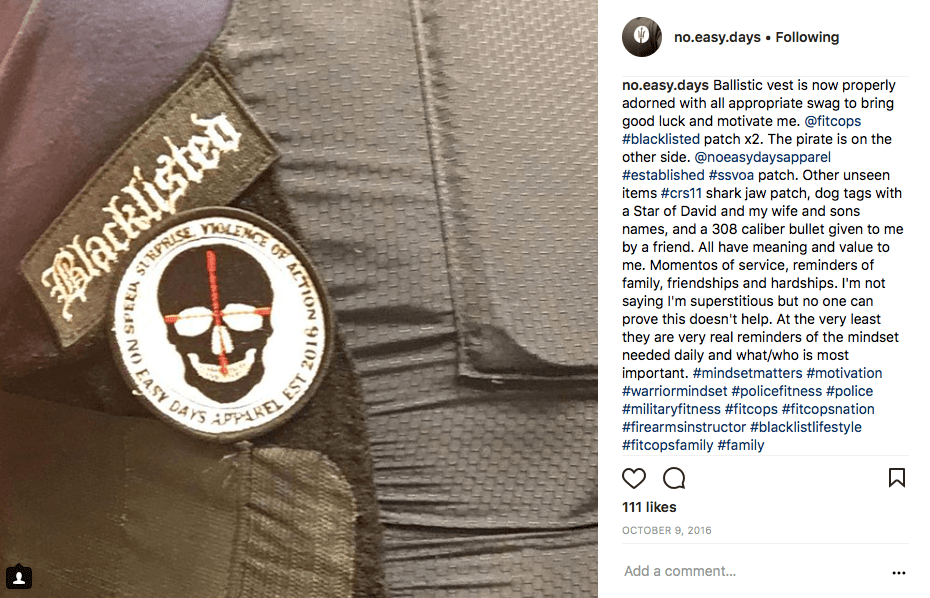
Here are a couple other posts that Sweeney put up.
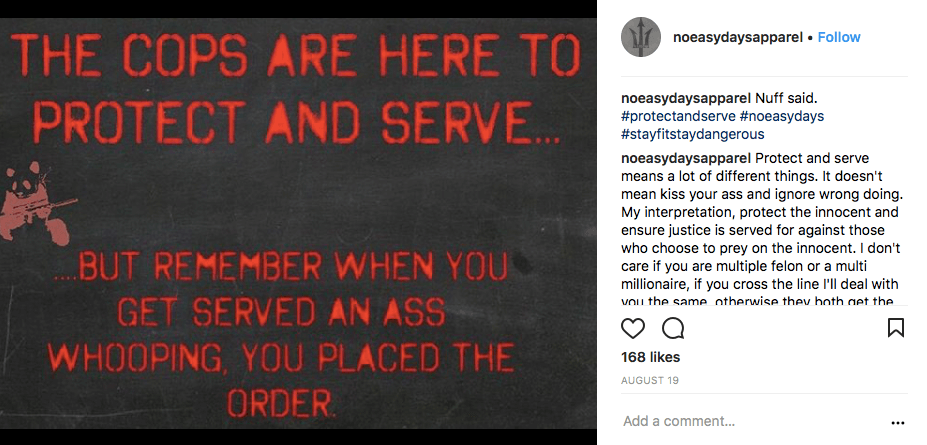

Surprisingly a jury found Sweeney guilty this week which is another way you know this was particularly egregious because those dudes are never found guilty of shit. He will face up to ten years in prison for killing Pigeon the man who wanted to die briefly but perhaps not irreversibly so. Perhaps he would have changed his mind.
Sweeney said he thought Pigeon was coming at him with a knife but he wasn’t.
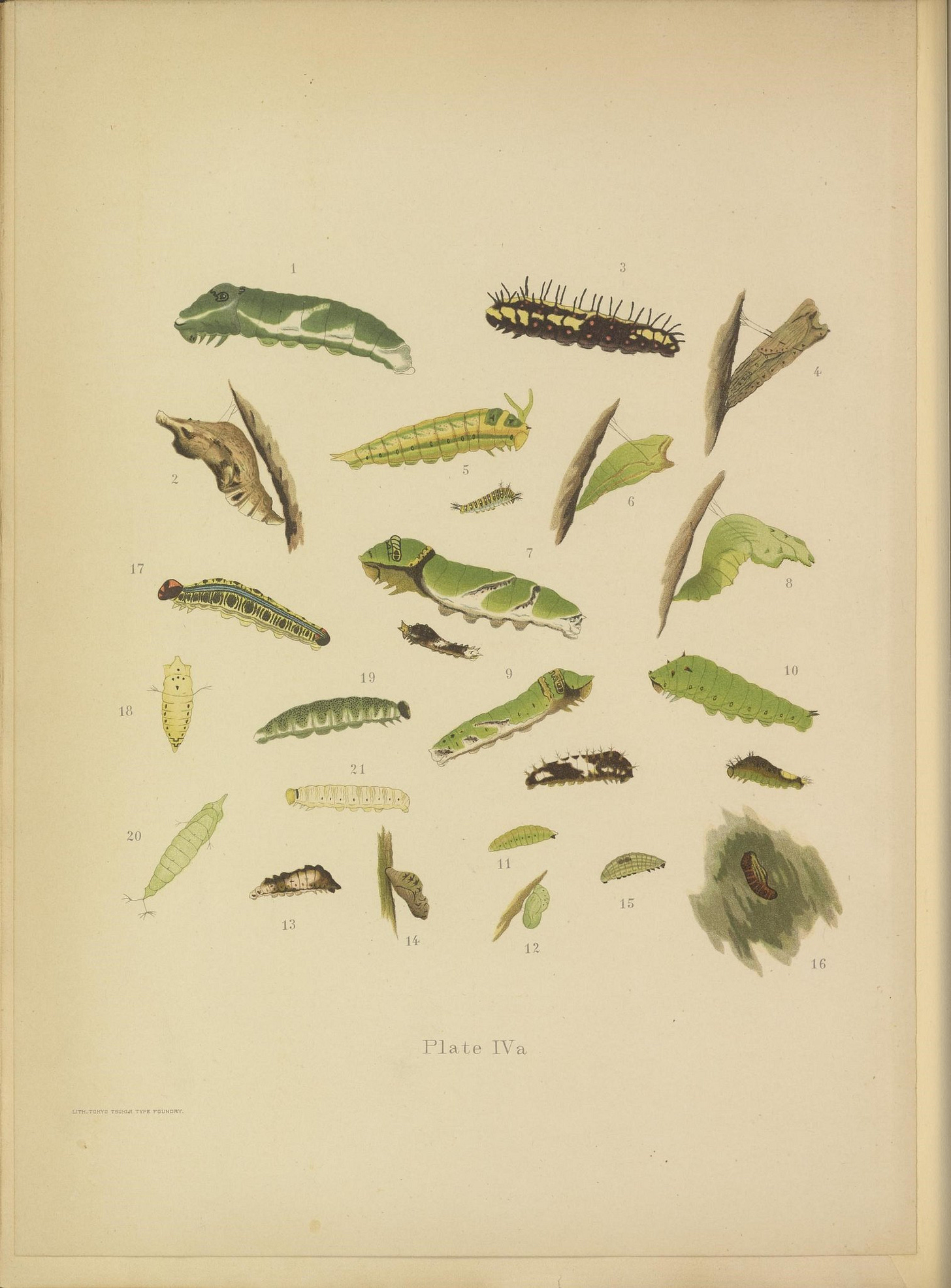
I went to therapy yesterday and she asked me how I had been and I said haha how much time do you have and she said about an hour and I said oh right.
Then she said it was time to do the survey she has to do every few months I guess to track my progress or something but I think it’s actually more of an insurance thing that operates on some profit margin bookkeeping level I can’t even begin to comprehend. She had me answer a bunch of questions by assigning a number value from 0 meaning never to 4 meaning all the time and there’s something so grim to me about the entire process and I wonder if there’s a spreadsheet somewhere that says my self harm ideation was a 2 in Q1 and a 3 in Q4 and if that’s collated in with everyone else’s answers and what they do with it and how the insurance company uses it to make sure the CEO has more boat time?
Let’s take a look at all the questions. Maybe you go to therapy and this is familiar to you or maybe you don’t and you want to play along at home.
How often do you…
Have little or no pleasure in doing things?
Feel depressed or hopeless?
Feel more irritated than usual?
Sleep less than usual but have a lot of energy?
Do more projects or risky things than usual?
Feel nervous or on edge?
Feel panicked or frightened?
Avoid situations that make you anxious?
Have unexplained aches or pains in your body?
Feel your illnesses aren’t being taken seriously enough?
Have thoughts of actually hurting yourself?
Hear voices or think people can hear your thoughts?
Have problems with memory?
Have unpleasant thoughts that come to mind, flashbacks, or triggers
Feel compelled to do certain behaviors over and over?
Feel distant from your body like disassociation?
Not know who you are or what you want from life?
Not feel close to other people or enjoy your relationships with them?
Drink four glasses of alcohol in a single day?
Smoke cigarettes?
Take meds not prescribed to you or illegal drugs?
My numbers were a little high in some areas this month but nothing too alarming I don’t think — I’m seeing a lot of depression here she said — but I just read that the CEO of McDonald’s is getting an exit package worth $42 million after being fired for having a sexual relationship with an employee and that is on top of the almost $24 million in stock options he can exercise now on the way out the door so please adjust all my previous answers to the brain survey to 4.
Stephen Easterbrook made around $16 million last year and the average salary for a U.S. worker at McDonald’s is $9 an hour. Don’t worry the poorer workers still do all sorts of sexual harassment too a situation that prompted protests around the country back in May with workers saying the company doesn’t take complaints seriously enough.
“What we see all the time from minimum-wage workers is that once you complain, retaliation is common," Sharyn Tejani the director of the Time's Up Legal Defense Fund told NPR.
“That takes the form of losing shifts, losing your job, not being able to stay at your job, being disciplined. And ... they don't have any cushion,” she said. “And when you compare that to what happens to somebody like the CEO, it's clear that there's a structural problem here.”
Here are two other quick things to boil your brain over before I get to the main part of today’s newsletter.

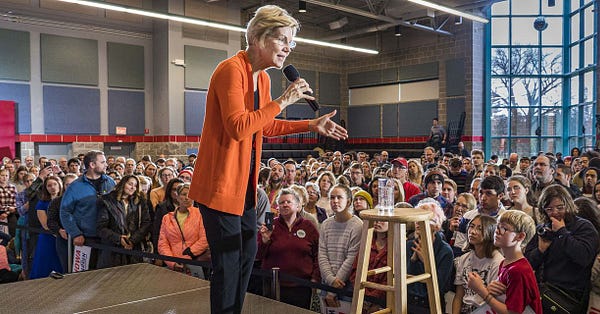
Overuse of healthcare????1?!??!?efsfhokfjsknfslf
It's amazing how many euphemism they get to use for “poor people are worthless piss mud” and we can't talk about what should really happen to the rich without getting into trouble.
What’s something that might make you happy my therapist asked me and I said marching all of the billionaires off a cliff and she said uh what else then I talked about how nice it was that so many of you came to my reading in Brooklyn the other night and how genuinely touched and appreciative I was but I said who gives a fuck though it doesn’t matter nothing matters when we still live in a country like this and nothing I am currently doing or capable of doing is going to change it.
I was genuinely happy for an hour or two there the other night though so thanks again for that.
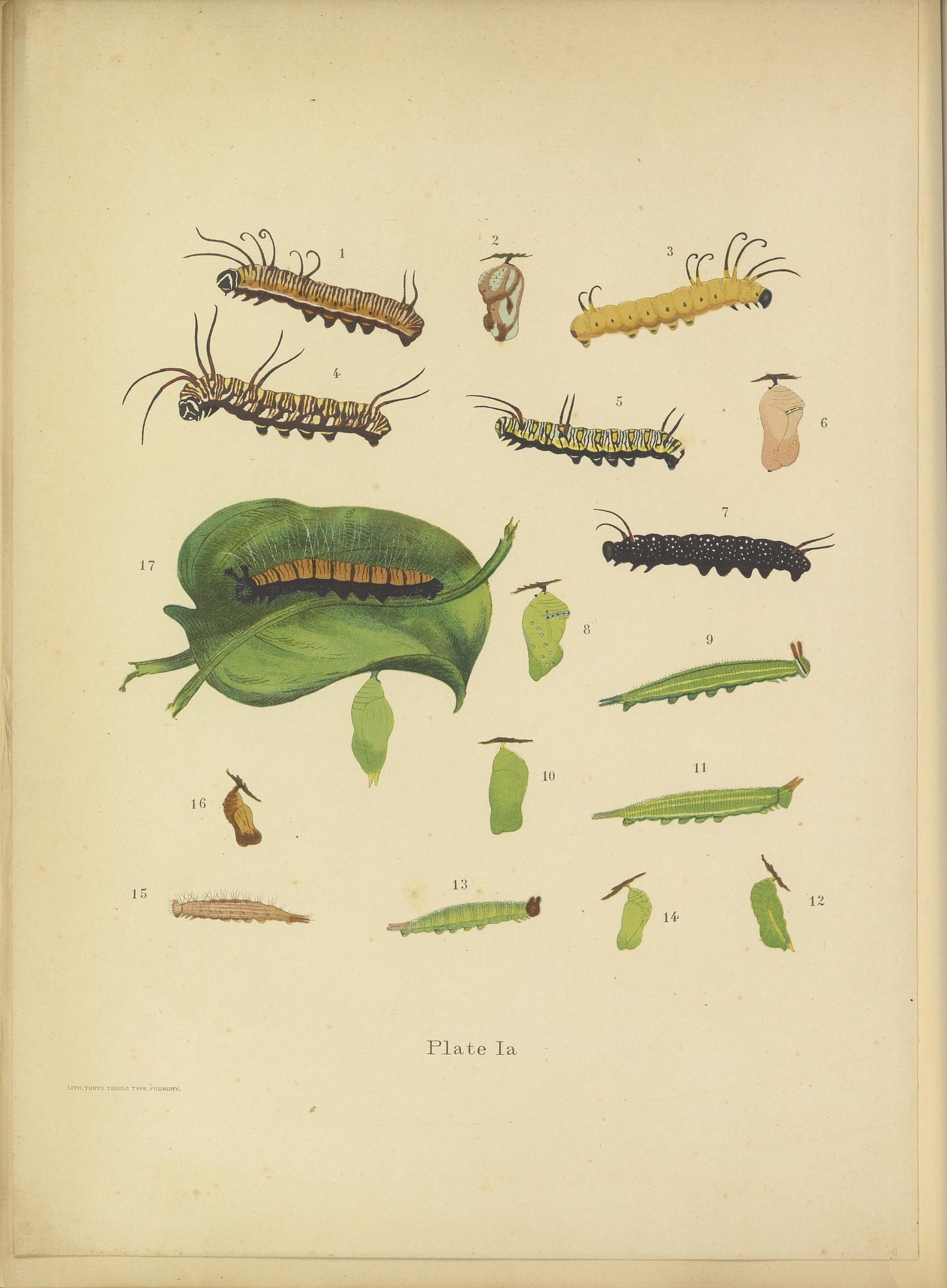
My pal Danny Gold and others just released a documentary they made about violence and poverty in St. Louis this week and here’s the description:
The Spiral of Violence and Discrimination in ‘the Gateway to the West’
St. Louis was once one of the largest cities in the United States, but today the city is in decline. The city that was once home to a population nearing a million and a healthy industry is now ravaged by poverty, crime, and violence.
Further complicating the city’s decay is endemic segregation created by the Delmar Divide. Delmar Boulevard splits the city in two, with the city’s wealth, resources, and White population predominantly living to its South.
The Red Line takes an in-depth look into the violence, poverty and discrimination dividing St. Louis and examines what some locals are doing to improve the situation in the city.

I spoke with Danny today to talk about the experience. You should watch it here but probably skip the first three minutes because for whatever reason the weird site that released the film put a voiceover on it from a guy that sounds like he’s doing a promo for a Transformers movie or some shit. It’s great otherwise.
What brought you to the story of St. Louis and what are some of the things you took away from the experience of reporting this personally?
I had reported in Ferguson a couple times in 2014, which is St. Louis County, not the city, but a lot of the same situations are there, so I was generally aware of it. In October or so of last year I was looking at some numbers about Chicago and the murder rate and things like that, and I found an article, I think in the Trace, that had a chart where you could see murder rates for the last few years. From 2014-2017, St. Louis was at the top of the list, significantly higher than Chicago or Baltimore. So that immediately piqued my interest.
I started reading about St. Louis and violence, learned about some of the other issues it’s had. It’s had this immense population decline, which you hear a lot about Detroit, but not St. Louis, which has been worse. It went from like 800,000 in the 1950s to a little over 300,000 now. It’s this giant amalgamation of every problem in America, whether it’s income inequality, segregation, poor policing due to racial dynamics, opioids, super-lax gun laws, and it all comes together in this murder rate.
Also economic stuff. It’s this Rust Belt city that had this decline in manufacturing starting in the 1960s and 70s and it really hasn’t recovered. You see this in a lot of Rust Belt cities. You have Buffalo, even though it’s kind of recovering, Cleveland, Milwaukee, Toledo, Columbus, Kansas City. The Midwest gets ignored unless it’s Detroit or Chicago, which have become this catchall for the problems of population decline or crime. The more I read and talked to people about it it seemed this city is crazy and it’s not getting enough attention.
There’s this concept you talk about in the documentary, The Delmar Divide, which is basically a literal red line through the city. Was it always that way?
The Delmar Divide is an east-west avenue, which is the dividing line for North St. Louis. North of Delmar it’s about 90% black, south is 60% white. North houses are worth 25% as much as houses south. All the economic issues are much worse in the north. And the population is around 100,000 there, so 1/3 of the city, and it has 2/3 of the murders every year.
It sort of came about I think as remnants of the Great Migration, when southern blacks and blacks from areas that had slavery flocked to Missouri in 1915 and years after that because it was this booming manufacturing time. But they were met with all this racial animosity. There were riots there, dozens of people were killed, and it became this kind of thing where they were like, ok, you guys can move here and have these jobs but you’re going to be in your own neighborhood, and we’re going to deprive those neighborhoods of the resources the white neighborhoods are going to get. I would say the more egregious laws were struck down as time went on, but others were left in place or there was an unspoken contract between homeowners and sellers to kind of keep black people in these neighborhoods.
We talk about this as well, you have issues in these neighborhoods where people can’t get mortgages, so they can’t buy their homes. It’s all these processes that went from formal, to less formal, to understood, just to keep these communities segregated, or to keep black people from either owning their homes or moving into white neighborhoods.
Being prevented from owning a home, that’s a generational curse of sorts that compounds itself over the decades.
Yeah that was news to me too because I didn’t realize how big an issue transferring houses is in generational wealth. A lot of wealth in America is transferred generationally through houses, and if people can’t buy their houses they can’t transfer that wealth and it keeps them trapped in a cycle of poverty. One of the big issues we talk about in the documentary, people in these neighborhoods in North St. Louis, even if they’re middle class, they have less of a chance of getting a mortgage than people in white neighborhoods that are of a lower economic strata.
Another thing that was crazy to me is I didn’t realize just how lax gun laws are in Missouri. And that is carried over even into heavily policed areas as well? You can just conceal carry there?
Yeah. We went out with the reverend in the documentary in the streets at night and you hear gunshots and it’s just normal. We were there in like 25 degrees whether, and he said in the summer you’re going to hear gunshots every five minutes. Everyone there has a gun. And it’s one of the most significant factors to why violence there is so bad as compared to other cities that have similar economic issues or segregation issues.
Did any of the police you talked to have opinions on lack of gun control?
We weren’t able to get official statements from the St. Louis police besides the woman that we interviewed. We talked to some police in East St. Louis, which is a separate city in Illinois across the border, and they were pretty vocal about the fact that they see a lot of guns on the streets and it feeds into the violence.
You even get a little sympathetic for the police in that regard. It’s not like in New York. There are guns in the street here but it’s a small amount. In St. Louis when there’s tension and shit’s going off, it’s a very high likelihood that people are armed. And the guns there lead to more police shootings because when they go out they expect everyone is going to have a gun and it’s not that far from the truth. It feeds into more animosity with law enforcement. Despite all this you don’t see statewide calls to limit guns because they don’t care.
It’s always weird to me, and I’m not saying — well, I don’t think anyone should have guns personally — but it’s weird to me that police and Republican lawmakers in some of the more violent cities in states where gun laws are pretty open, still don’t even really speak up for gun control.
Yeah it makes no sense for them. They’re the ones who have to deal with this shit on the streets all the time. Especially concealed carry, which is so easy to get.
How many murders a year is it?
It’s like 180-200 for a population of 300,000. It ends up being around 60-70 per 100,000 which is how they do murder rates. Everyone hears about Baltimore. Last year I think they had 54 and Chicago had something in like the low 20s.
You’ve been to El Salvador too. What’s it like there?
In some years it’s been up in the 90s but in recent years it’s been lower than St. Louis. The real way to look at this I think is to do it on a smaller neighborhood basis. In Chicago in some of the neighborhoods on the South Side they have murder rates up in like 150-200 something like that. In St. Louis you have neighborhoods that are like 4-5000 people that are like 15 murders per year which is absurd.
I don’t want to give the impression that all of St. Louis is like this. You can go to South St. Louis in some of the nicer neighborhoods and you’re not going to have an issue at all. People there probably don’t have any idea what it’s like in the North. It’s a cliche but it’s like a tale of two cities. It’s a beautiful city, with a great food scene, amazing barbecue, but there is a part of the city that is completely neglected, and it seems like it was done so purposefully, and things are really bad there.
We had to cut some stuff out, but there are people doing amazing community work and trying to beautify it but they need some help.
There was I think a city counselor in the documentary who started an initiative to sell a lot of these abandoned homes for $1?
It’s tough because it’s a great program, and the thing with these vacant houses as he explained it is that if you live in these neighborhoods and you see these shitty vacant houses everywhere it affects your mind state. They really contribute to the feel for the neighborhood. If you’re 18 years old walking around your community and it looks like shit it’s going to change the way you feel and how you see your future.
You can sell the houses for $1 but it’s hard because they need a lot of work. The program is legit but it’s not an easy thing to make work. You sell it for $1 and it takes tens of thousands to make them livable and not a lot of people have that.
Talking about all these cities with all these murders, these seem to be places with gun violence that doesn’t really “count.” We’ve somehow accepted that ten killed in a weekend in a city like this is just standard operating procedure of life in America. Whereas if ten killed in a place where “you’re not supposed to expect people to get killed” then it’s on CNN for 48 hours.
100%. First off St. Louis is in the Midwest so it’s not going to get a lot of attention. Second let’s look at the people who are getting killed. It’s black men between the ages of 18-45. People doing the killing are black men as well. The people in charge of our country don’t care about black men getting killed. It doesn’t make the news because people don’t think it’s a big deal. The people who make the decisions about what is a big deal. And it’s really traumatic. People are living with a tremendous amount of trauma.
Obviously it’s not an easy issue to solve. Some people want to come in with more police and that could potentially make things worse. But it’s something I think needs to be addressed. There are some solutions, whether it’s money for after school programs that have been cut in recent years, or gun laws, or more resources for the drug problem. The opioid problem in Missouri is gigantic. And a lot of the people coming to buy drugs in the North are white people. But there’s no resources to deal with addicts there or get people treated, especially in a conservative state. There are things that could be done but there doesn’t seem to be the amount of attention being paid if there were four white kids killed somewhere else.
No one cares about these cities unless they want to use it as a hammer against Democrats. You talked to a lot of people who seemed like great people who are refusing to accept that this is how it has to be. Did you come away with any hope? It’s easy to just be so cynical here.
The Reverend Kenneth McCoy. This is a guy who really lives this life. He is out in the streets every day trying to treat addicts like human beings, trying to get guys who live violently to rethink situations which could lead to violence.
I look at someone like Demetrius Johnson who runs that youth center that also helps young black men who have criminal violations get into the workforce and unions in construction. It’s at a small level but it’s incredible. He’s legitimately changing lives. I don’t understand why there hasn’t been federal money pouring into something like that. Demetrius said it: These guys, their schools are messed up, they have no resources, they get these bullshit misdemeanor charges that are made into felonies, and there are no jobs in St. Louis to begin with. What do you think is going to happen when they get out and can’t get a job because of these charges? So he’s got this plan that should be replicated all around the country.



“When you’re holding a gun everyone’s heart looks like a target.“ Fuck, man.